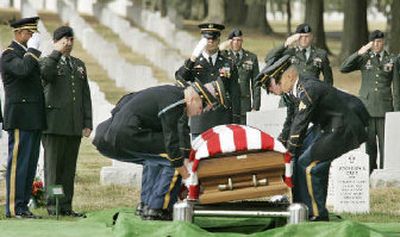Reservists fall at higher rate

WASHINGTON – The National Guard and Reserves are suffering a strikingly higher share of U.S. casualties in Iraq, their portion of total American military deaths nearly doubling since last year.
Reservists have accounted for one-quarter of all U.S. deaths since the Iraq war began, but the proportion has grown over time. It was 10 percent for the five weeks it took to topple Baghdad in the spring of 2003, and 20 percent for 2004 as a whole.
The trend accelerated this year. For the first nine months of 2005 reservists accounted for 36 percent of U.S. deaths, and for August and September it was 56 percent, according to Pentagon figures.
The Army National Guard, Army Reserve and Marine Corps Reserve accounted for more than half of all U.S. deaths in August and in September – the first time that has happened in consecutive months. The only other month in which it even approached 50 percent was June 2004.
Casualties in Iraq have shifted toward citizen soldiers as their combat role has grown to historic levels. National Guard officials say their soldiers have been sent into combat in Iraq in numbers not previously seen in modern times – far more than were sent to Vietnam, where active-duty troops did the vast majority of the fighting.
Charles Krohn, a former Army deputy chief of public affairs, said the reservists are taking up the slack for the highly stressed active-duty Army.
“Decisions made years earlier made going to war in any significant way impossible without Guard and Reserve participation. But I can’t imagine anyone postulated the situation we face today: We don’t seem very anxious to bring back the draft, and we can’t get enough volunteers for a war that is not universally popular,” Krohn said.
Forty-five percent of all Guard and Reserve deaths since the start of the war – 220 of the 487 total – occurred in the first nine months of 2005, according to Pentagon figures. The deadliest month was August, when 49 Guard and Reserve members died.
The mounting casualties among reservists in Iraq has been overshadowed by the attention focused on a rising overall U.S. death toll, now approaching 2,000. It complicates recruiting for the National Guard and Reserve, which often attract people who think of the military reservists’ role as something other than front-line combat.
Gone are the days when the National Guard and Reserve served mainly as “rear-area” support, far from the front-line fighting.
In Iraq the front line is everywhere – on rural roads where Guard and Reserve soldiers drive supply trucks, at urban checkpoints, in remote villages and at major supply bases. Some units also have been attached to active-duty units with the specific mission of conducting offensive operations.
At one point this year more than half of the combat forces in Iraq were National Guard.
“That’s a first,” said Army Maj. Les Melnyk, historian for the Pentagon office that manages the Army and Air National Guard. “The Guard can’t claim that (level of combat) for World War II or World War I – the other major wars we fought in.”